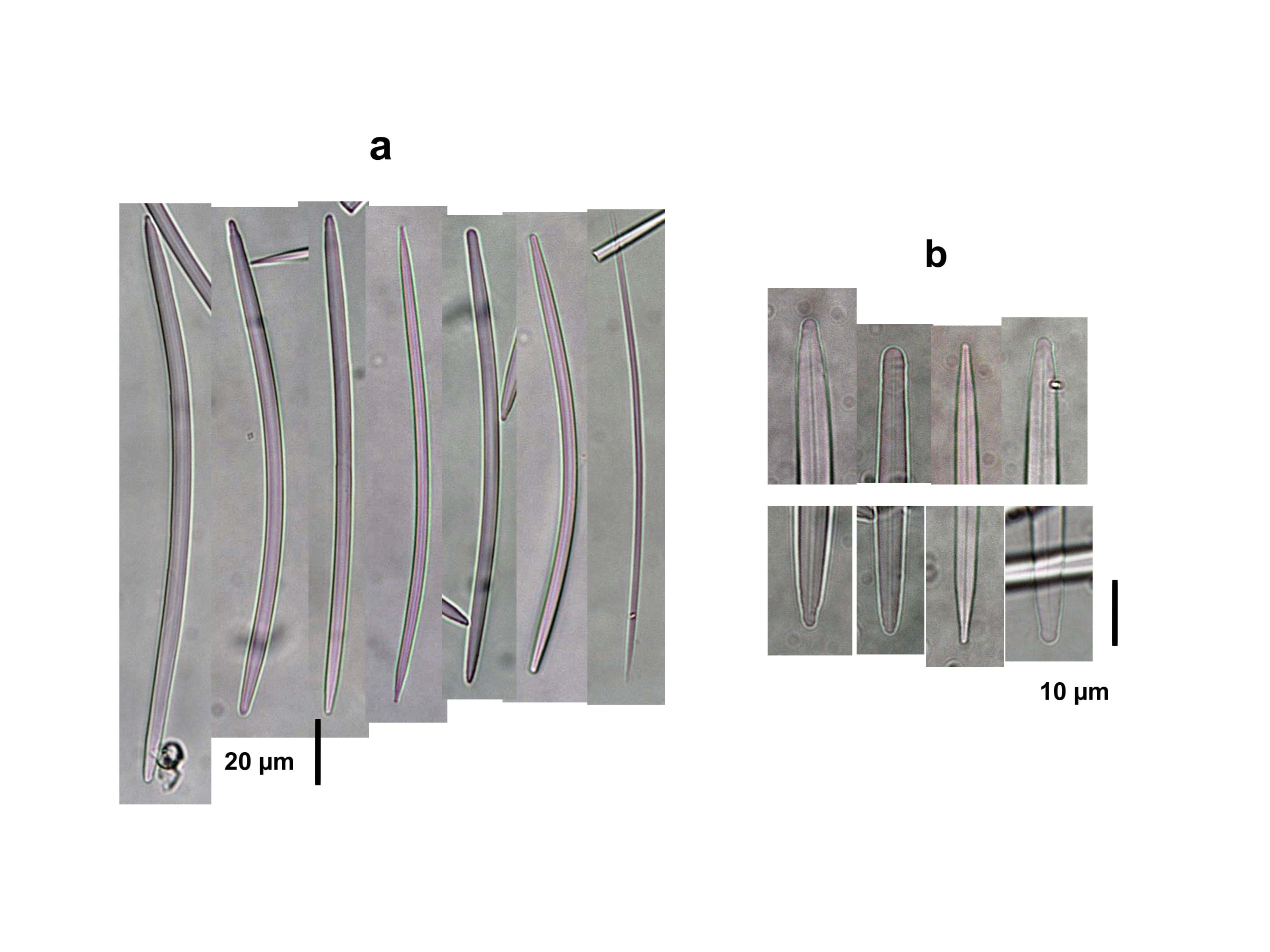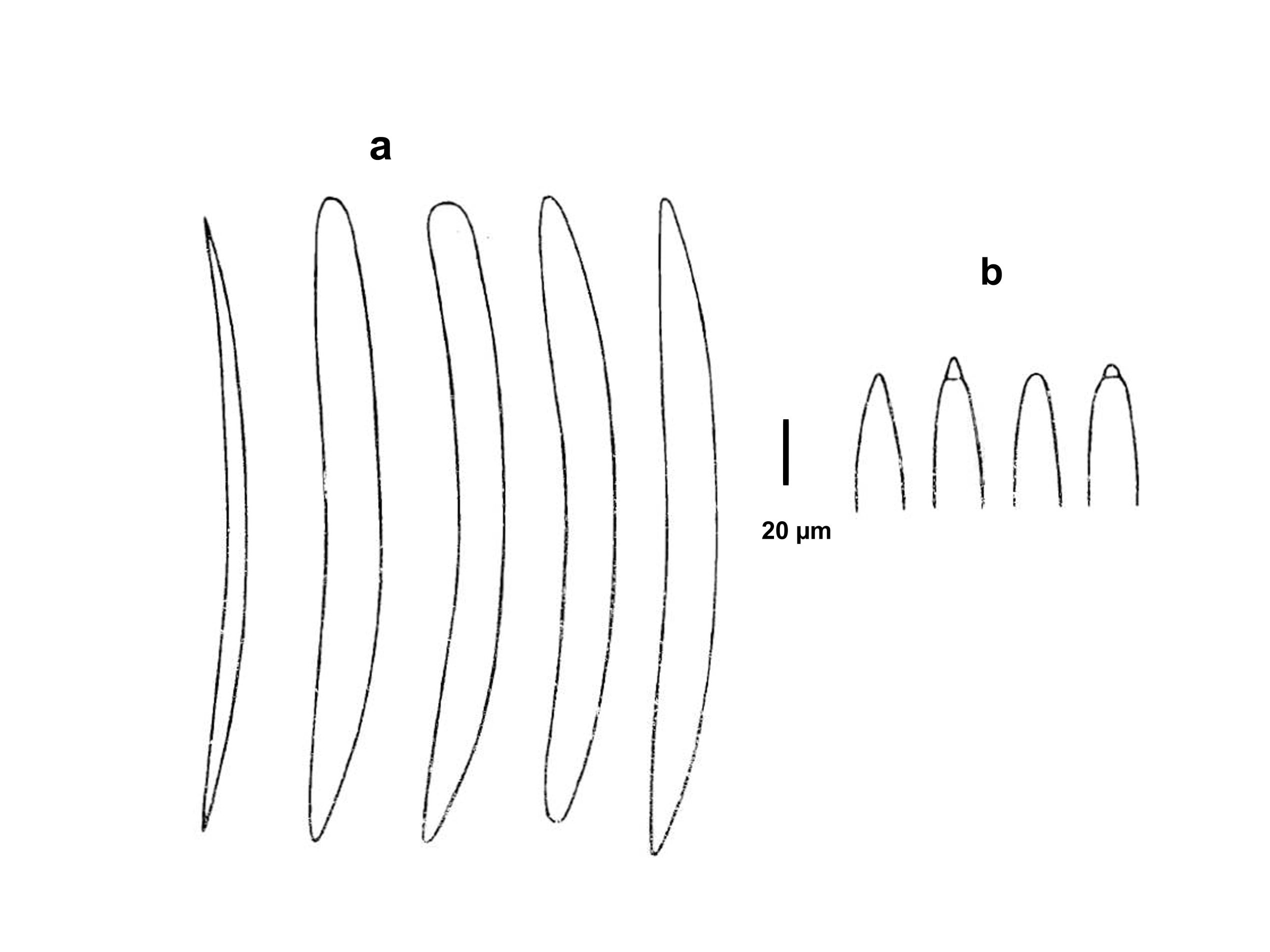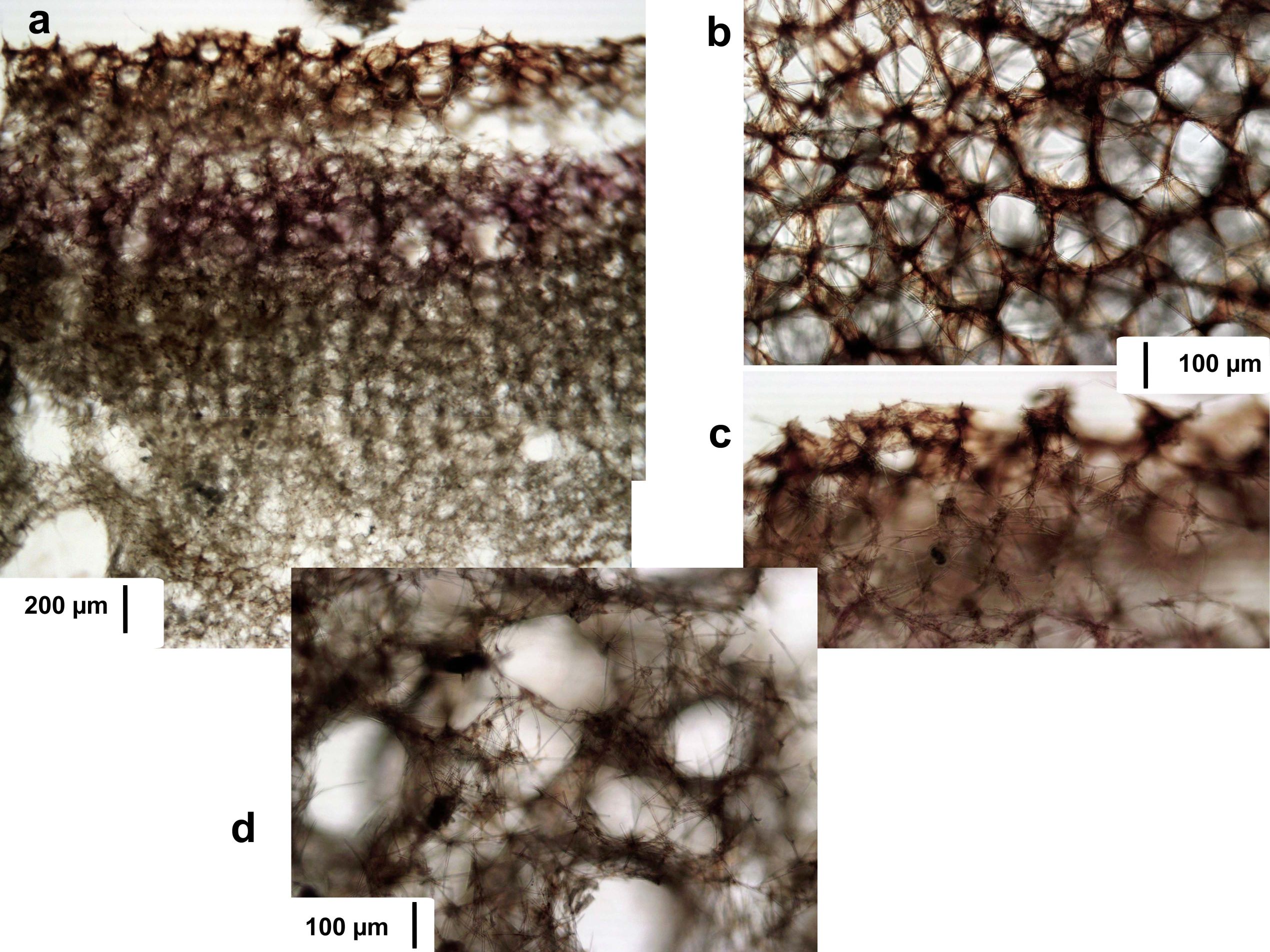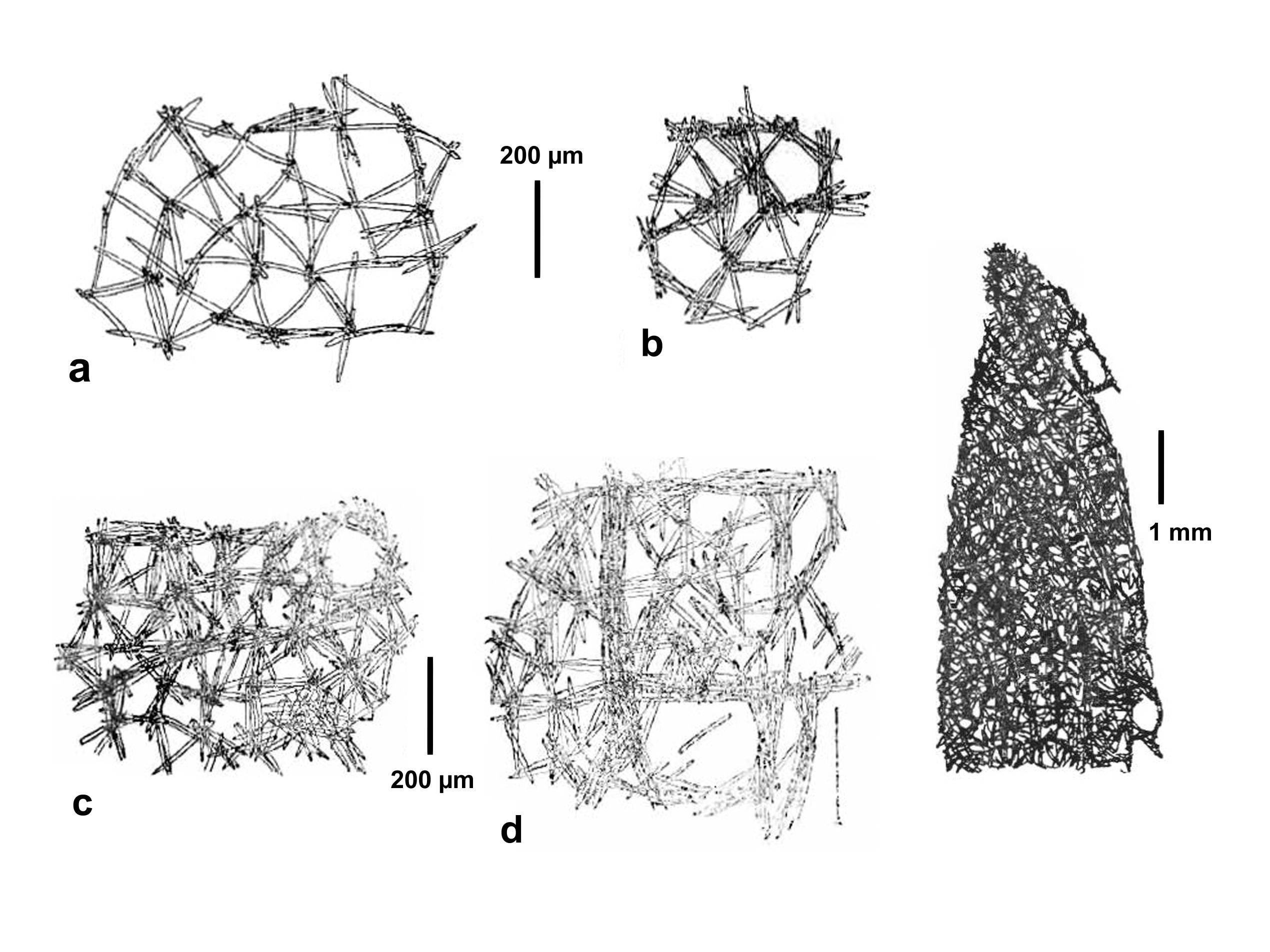the Sponge Guide - www.spongeguide.org
Observed Characteristics:
black
brown
cream
branching
encrusting
lobate
massive
tube
vase
hard
Bahamas
Colombia
Panama
Saint Eustatius
Species Description and Notes
Description: In the western and northern Caribbean and the Bahamas, this species occurs as low, dark brown to black tubes, up to about 5-10 cm tall and up to 3-5 cm in diameter, often partly buried or with a basal mass widely filling crevices from which low tubes protrude; the surface may be riddled with 1-3 mm wide holes and there may outgrowths as 1-2 mm branchelets a few cm long. In the southern Caribbean it occurs as long, reddish brown, usually smooth tubes, single or in groups, sometimes reaching 1 m in height and 5-10 cm in diameter, with walls up to about 1-2 cm thick; the surface may be riddled with zoanthids or hydroids; oscules small, up to about 1 mm in diameter, aligned in concentric lines in the inner surface of the tubes. Consistency stony hard, difficult to cut and break, although smaller specimens may have crumbly areas over subdermal cavities. The skeleton is an irregular, isotropic, uni- to paucispicular (up to 5-8 spicules) reticulation, forming triangular to irregular, closed meshes, up to 100 µm wide; here and there, the skeleton surround rounded, 300-650 µm wide canals. Near the surface, the skeleton becomes more open and more anisotropic, with clear ascending and interconnecting tracts, that end up at the surface supporting a unispicular reticulation of triangular meshes. In cross sections of tubes the radial-ascending growth lines can be seen with the naked eye. Spicules are hastate oxea to strongyloxea, slightly curved, with pointed, rounded, or mammiform endings, sometimes slightly asymmetric as to appear slightly styloid. Size in the Bahamas is smaller and thinner (120-170 by 2-5.5 µm) than in continental Colombia (100-212 by 0.8-11.6 µm).
Notes: This is a shallow to deep reef species, living exposed. It was originally described under genus Xestospongia. Crevice-filling, young specimens may be confused with similarly-shaped Calyx podatypa (de Laubenfels, 1934), also pictured here, which are also brown, but more crumbly and have smaller and thinner spicules (92-122 x up to 2 µm in the Bahamas, and 95-190 x 1.9-10.4 µm in continental Colombia). Northern Caribbean blackish specimens need also careful comparison with N. carbonaria (Lamarck, 1814), also pictured here, which should have larger spicules and thicker skeletal tracts. The striking regional variability in overall shape and color should be further analyzed to check if they are indeed the same species, and careful comparisons with coexisting C. podatypa and N. carbonaria still need to be made. Deep-water, pale beige Xestospongia cf. rosariensis sensu van Soest & Stentoft (1988) was recently described as new Neopetrosia dutchi van Soest, Meesters & Becking, 2014.
Author Reference: (Zea & Rützler, 1983)
Link: World Porifera Database
Tissue and Spicule Images

Spicule Images: a) Oxeas to strongyloxeas and styloids; b) ends of spicules. Sample from the Bahamas.
Source Specimen: http://www.spongeguide.org/ thumbs/00063/01708.JPG

Spicule Images: Drawings of spicules of material from Colombia. a) Oxeas to strongyloxeas and styloids; b) ends of spicules (from Zea & Rützler, 1983, fig. 7, as Xestospongia rosariensis).
No source specimen image available

Tissue Images: a) Perpendicular section (surface above); b) tangential view of the ectosome; c) enlargement at the surface; d) view of the choanosome. Sample from the Bahamas.
Source Specimen: http://www.spongeguide.org/ thumbs/00063/01708.JPG

Tissue Images: Drawings of the skeleton of material from Colombia. a), b) Tangential view of the ectosome; c), d) views of the choanosome; e) longitudinal section through the axis of a tube (from Zea & Rützler, 1983, figs. 4-6, as Xestospongia rosariensis).
No source specimen image available
Images
Neopetrosia rosariensis
Location: Saint Eustatius
Photographer: Joseph Pawlik
Location: Bahamas, Little Inagua
Photographer: Sven Zea
Location: Bahamas, Little Inagua
Photographer: Sven Zea
![<i>Neopetrosia rosariensis</i> <br />[Colombia, Islas del Rosario]](thumbs/00117/02108.jpg)
Location: Colombia, Islas del Rosario
Photographer: Sven Zea
Location: Colombia, Santa Marta
Photographer: Sven Zea
![<i>Neopetrosia rosariensis</i> <br />[Colombia, Santa Marta]](thumbs/00117/02110.jpg)
Location: Colombia, Santa Marta
Photographer: Sven Zea
Location: Panama, Bocas del Toro
Photographer: Sven Zea
Location: Panama, Bocas del Toro
Photographer: Sven Zea
Location: Panama, Bocas del Toro
Photographer: Sven Zea
Location: Panama, Bocas del Toro
Photographer: Sven Zea
![<i>Neopetrosia rosariensis</i> <br />[Colombia, San Andrés Archipelago, Albuquerque Cays (atoll)]](thumbs/00117/02115.jpg)
Location: Colombia, San Andrés Archipelago, Albuquerque Cays (atoll)
Photographer: Sven Zea
![<i>Neopetrosia rosariensis</i> <br />[Colombia, San Andrés Archipelago, Albuquerque Cays (atoll)]](thumbs/00117/02116.jpg)
Location: Colombia, San Andrés Archipelago, Albuquerque Cays (atoll)
Photographer: Sven Zea
Location: Colombia, San Andrés Archipelago, San Andrés Island
Photographer: Sven Zea
Location: Colombia, San Andrés Archipelago, San Andrés Island
Photographer: Sven Zea
![<i>Neopetrosia rosariensis</i> <br />[Colombia, Islas del Rosario]](thumbs/00117/02119.jpg)
Location: Colombia, Islas del Rosario
Photographer: Sven Zea
Location: Colombia, San Andrés Archipelago, San Andrés Island
Photographer: Sven Zea
![<i>Neopetrosia rosariensis</i> <br />[Colombia, Islas del Rosario]](thumbs/00117/02121.jpg)
Location: Colombia, Islas del Rosario
Photographer: Sven Zea
![<i>Neopetrosia rosariensis</i> <br />[Colombia, Islas del Rosario]](thumbs/00117/02122.jpg)
Location: Colombia, Islas del Rosario
Photographer: Sven Zea
![<i>Neopetrosia rosariensis</i> <br />[Colombia, Islas del Rosario]](thumbs/00117/02123.jpg)
Location: Colombia, Islas del Rosario
Photographer: Sven Zea
![<i>Neopetrosia rosariensis</i> <br />[Colombia, Islas del Rosario]](thumbs/00117/02124.jpg)
Location: Colombia, Islas del Rosario
Photographer: Sven Zea
![<i>Neopetrosia rosariensis</i> <br />[Colombia, Islas del Rosario]](thumbs/00117/02125.jpg)
Location: Colombia, Islas del Rosario
Photographer: Sven Zea
![<i>Neopetrosia rosariensis</i> <br />[Colombia, Islas del Rosario]](thumbs/00117/02126.jpg)
Location: Colombia, Islas del Rosario
Photographer: Sven Zea
![<i>Neopetrosia rosariensis</i> <br />[Colombia, Islas del Rosario]](thumbs/00117/02127.jpg)
Location: Colombia, Islas del Rosario
Photographer: Sven Zea
Location: Colombia, Islas del Rosario
Photographer: Sven Zea